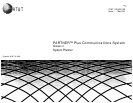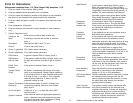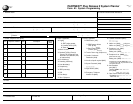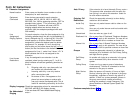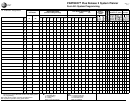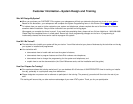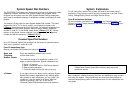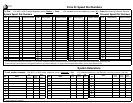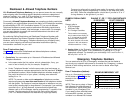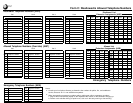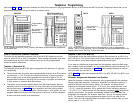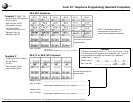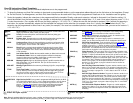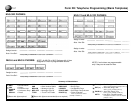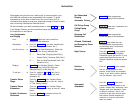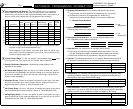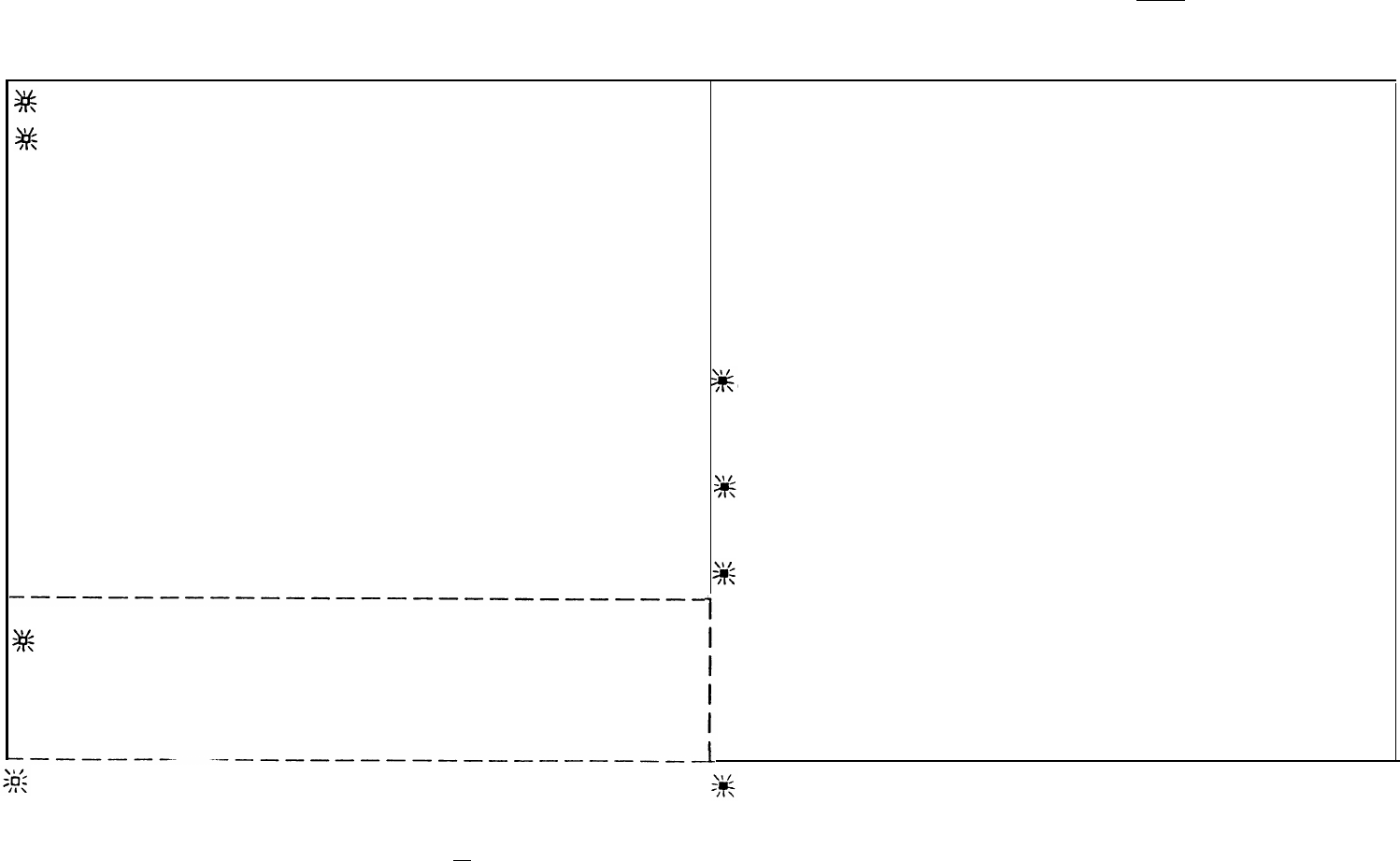
Form D2 Instructions (Blank Templates):
Fill in the templates to indicate how the individual telephones are to be programmed:
1.
To show the features and Auto Dial numbers to be stored on programmable buttons, put the appropriate abbreviations from the list below on the templates. (Except
for Do Not Disturb, Fax Management, and Auto Dial, these features can be used even if they are not programmed. Details are in the Installation and Use guide.)
2.
Under the template, indicate the extensions to be programmed like the template. Directly under each extension, indicate its Automatic Line Selection setting, if it
should be different from the factory setting—for example, to indicate that an extension should select outside lines 1, 2, 3, and 4, then select Intercom, enter “1 2 3 4,
l” under the extension. (On a system with 8 lines, the factory setting is “1 2 3 4 5 6 7 8, I.”) When the user lifts the handset or presses [ Spkr
] without first pressing a
line button, the system automatically selects the first available line assigned to the extension (for example, when line 1 is busy, the system selects line 2). The
extension can be programmed to select lines in any order (for example, if the user has a standard phone or makes mostly intercom calls, you can set the order to “I,
1 2 3 4 5 6 7 8”).
DND
PRIV
EXHOLD
DROP
RECALL
LNR
SNR
MSG-ON
MSG-OFF
TT-EN
Do Not Disturb.
Prevents calls from ringing on your phone. Outside callers hear
ringing, and intercom (inside) callers get a busy signal.
Privacy.
Prevents other phone users with the same line from joining your
telephone conversations.
Exclusive Hold.
Guarantees that your call remains private when you place it on
hold. Prevents others with access to the line from picking up the call.
Conference Drop.
Allows the last outside party you add to a conference call to
be dropped from the conference, without disconnecting the other parties. (For a
Centrex system, use the Centrex code instead.)
Recall.
Sends a precisely-timed switchhook flash through the system. When
you are using the handset, Recall gives you a dial tone without your having to
depress the switchhook. Also used to access PBX/Centrex features that require
a flash operation.
Last Number Redial.
Redials the last outside number you dialed, with one touch.
Save Number Redial.
Saves an outside telephone number into temporary
memory for later one-touch redialing. Useful when you will need to redial a
number but want to make other calls before redialing.
Message Light On.
Lights up the Message light at a specific extension with an
MLS-model phone. You press MSG-ON, then you dial that extension. Its
message light will go on.
Message Light Off.
Works the same way as Message Light On, except the light
goes off.
Touch-Tone Enable.
If you have a rotary line, allows you to use phone services
such as “Bank-by-Phone” that require dialing touch-tone digits. After you place
the call to the service and are asked to enter touch-tone digits, press TT-EN to
change the rest of the digits you dial during the call to touch-tone.
GRP-CALL
GRP-PAGE
LOUDSPK
PICKUP-GRP
PICKUP-(x)
FAX-(x)
EXT-(x)
PAGE-(x)
Group Call.
Simultaneously rings all extensions in the Calling Group
(see form A2). You are connected to the first extension to answer.
Group Page.
Simultaneously voice signals (pages) all extensions in the
Calling Group that have MLS-model telephones.
Loudspeaker Page.
If an optional paging system is connected to your
system, you can make announcements over its loudspeaker with one touch.
Call Pickup Group–Answer.
From your phone, picks up an outside call
ringing at any extension assigned to the Call Pickup Group (form A2). For
example, if you are Ext. 11, and Ext. 30 (which is in the group) rings, you
can pick up the call ringing at Ext. 30 from your phone by pressing
PICKUP-GRP. Your extension does not need to be in the Call Pickup Group.
Useful when the ringing line is not assigned to your phone.
Pickup Extension.
From your phone, picks up an outside call ringing at the
extension you specify on the template. For example, to pick up Ext. 11, enter
PICKUP-11. Helpful for officemates who want to pick up calls for each other.
Fax Management.
Allows you to transfer calls to the fax machine with one
touch. Also, if you program on a button with lights, allows you to see when the
fax machine is busy, and when it is having trouble and not answering (e.g.,
when it is out of paper). On the template, indicate the extension the fax
machine is on. For example, to program a button for the fax machine on
Ext. 12, enter FAX-12.
Auto Dial (Ring)–Extension Number.
Programs another extension onto a
button, so you can dial it with one touch. If you program a button with lights,
you can also see when the extension is busy and when it is transferring a call
to you. For example, to program Ext. 15 onto a button, enter EXT-15 on the
template.
Auto Dial (Page)–Extension Number.
Programs the intercom number for an
extension with an MLS-model phone onto a button, so you can voice-signal
(page) the extension with one touch. (This feature cannot be used to page
extensions that have standard or MLC-6 phones.) If you program a button with
lights, you can also see when the extension is busy and when it is transferring
a call to you. For example, to program a button to page Ext. 15, enter PAGE-
15 on the template.
Auto Dial–Outside Telephone Number.
Programs an outside telephone
number onto a button, so you can dial the number with one touch. On the
template, put the name or telephone number (the abbreviation AUTO is not
necessary).
NIGHT-SVC Night Service On/Off.
If your system is programmed with Night Service, the MLS-
120 or MLS-34D telephone at Ext. 10 has a Night Service button to turn the feature
on and off (users at other extensions cannot program Night Service onto their
phones). The Night Service button is always the second lighted programmable
button (see template 1 on form D1). Once a Night Service button has been
AUTO-(x)
assigned, other features cannot be programmed onto that button.
Button with lights required
Button with lights recommended (but not required)
Note:
Although standard single-line touch-tone, rotary, cordless, and feature phones cannot be programmed, you can use some of the
features in the above list with these standard phones by pressing [ #
] and a 2-digit code. Details are in Installation and Use guide.



